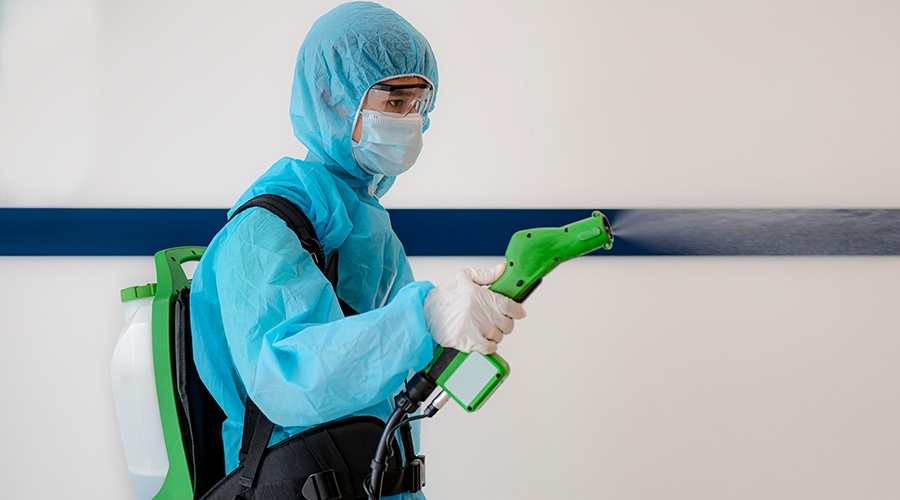Electrostatic sprayers (ESS) used on pre-cleaned surfaces can enhance the effectiveness of a disinfectant by providing a more thorough, even distribution of the disinfectant solution on a surface. Pre-cleaning the surface helps remove dirt, debris and organic matter, which can interfere with the disinfection process by shielding microorganisms from the disinfectant. By removing these materials from surfaces, the disinfectant can come into direct contact with the pathogens and have a better chance of effectively killing them.
But during the early months of the COVID-19 pandemic, I saw workers in hazmat suits applying disinfectants to public spaces, including classrooms and elevators. Without pre-cleaning surfaces before applying disinfectants with an ESS, this process was merely hygiene theater. It quickly became apparent that standards are needed for ESS and the application of disinfectants in order to protect the public’s health and safety.
Setting standards
Here is a short list of suggested ESS standards:
Test methodology. The cleaning industry needs a concise test methodology for ESS and a seal of approval so end users are assured that the product meets a minimum standard before purchasing. Among the factors that influence the performance of an ESS in real-world facilities are these:
- median droplet size
- angle of contact for the droplets impacting the surface and angle of the ESS sprayer nozzle
- number of room air exchanges
- size and shape of the surfaces being disinfected
- amount of liquid disinfectant delivered to the surface.
Disinfectant efficacy. The U.S. Environmental Protection Agency considers ESS to be low-pressure sprayers. Any disinfectant labels that include the language "low-pressure sprayer" or "low-pressure coarse sprayer" indicate that the product can be used through an ESS. It is important to note that the efficacy of disinfection depends not only on the application method but also on the specific disinfectant used and the contact time required for that particular disinfectant to be effective against the target microorganisms. Disinfectants have varying kill times and effectiveness against different pathogens, so it is crucial to follow the manufacturer's instructions for the specific disinfectant being used.
Training. While ESS is an effective tool for disinfecting a range of surfaces, effective training of ESS technicians is required to ensure comprehensive coverage and results. The ESS nozzle, where the positive or negative charge is put into the droplets, is not a magic wand that can be waved quickly over a surface. Educating and training the ESS team is essential for the best outcomes.
Auditing. After a room has been pre-cleaned and the disinfectant has been applied with an ESS, the disinfectant coverage can be verified with the use of an ultraviolet light in a semi-darkened room. Write an auditing protocol that verifies that the ESS process is being performed according to hospital and department standards. Keep records of audits.
While an electrostatic sprayer can improve coverage and distribution of disinfectants, it should not be seen as a replacement for proper cleaning and disinfection protocols. Thorough cleaning to remove dirt and organic matter followed by appropriate disinfection remains essential for maintaining a clean and hygienic environment.
J. Darrel Hicks, BA, MESRE, CHESP, Certificate of Mastery in Infection Prevention, is the past president of the Healthcare Surfaces Institute. Hicks is nationally recognized as a subject matter expert in infection prevention and control as it relates to cleaning. He is the owner and principal of Safe, Clean and Disinfected. His enterprise specializes in B2B consulting, webinar presentations, seminars and facility consulting services related to cleaning and disinfection. He can be reached at darrel@darrelhicks.com, or learn more at www.darrelhicks.com.

 Healthcare Is the New Retail
Healthcare Is the New Retail Bridgeway Behavioral Health Services Launches Campaign to Renovate Health Center
Bridgeway Behavioral Health Services Launches Campaign to Renovate Health Center Ground Broken for New North Dakota State Hospital
Ground Broken for New North Dakota State Hospital AI Usage for Healthcare Facilities
AI Usage for Healthcare Facilities Ground Broken on Pelican Valley Senior Living Modernization Project
Ground Broken on Pelican Valley Senior Living Modernization Project